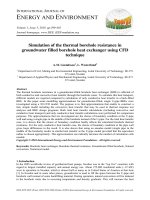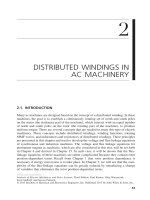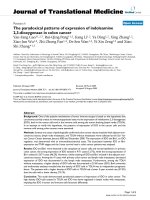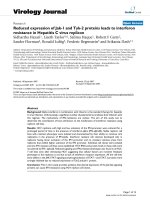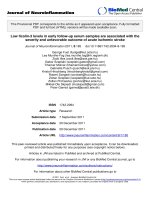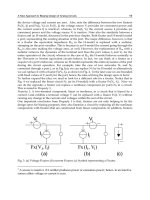Topic 3 resistance in AC circuits topic a3
Bạn đang xem bản rút gọn của tài liệu. Xem và tải ngay bản đầy đủ của tài liệu tại đây (72.52 KB, 16 trang )
Solve problems in single and threephase low voltage circuits
Part A
Topic 3: Resistance in
AC Circuits
Resistance in AC Circuits
Resistive Component
–
–
Any device that consists of a ‘conductor’ with an atomic
structure that does not allow electrons to move as easily as
a normal conductor.
A resistive component’s function is to convert electrical
energy into heat energy.
Key Characteristic
–
–
A resistive component will OPPOSE THE FLOW OF
CURRENT.
It achieves this by slowing the flow of electrons by not
allowing them to cascade through as quickly.
Resistance in AC Circuits
Symbol ~ R
Unit of measurement ~ OHMS (Ω)
Resistance in AC Circuits
In a purely resistive AC circuit, the circuit can
be analysed using the same principles as DC
circuits.
–
–
–
–
–
Ohm’s Law
Resistors in Series
Resistors in Parallel
Kirchoff’s Voltage Law
Kirchoff’s Current Law
Resistance in AC Circuits: Ohm’s Law
VR
R
VR
IR
IR
R
VS
ƒ
Simple Resistive Circuit
Ohm’s Law – Resistive component
Resistance in AC Circuits: Resistance
in Series and Parallel
R1
R1
R2
R2
VS
ƒ
IS
VS
ƒ
Resistance in Parallel
Resistance in Series
RTotal= R1+R2+…
1
= 1 + 1 +…
RTotal R1 R2…
Kirchoff’s Voltage Law: Series
Resistive Circuit
VR1
VR2
R1
R2
Kirchoff’s Voltage Law
•The ‘sum’ of the voltage drops in
the circuit will equal the supply
voltage
VS
Vs = VR1 + VR2+…
ƒ
[Purely resistive circuit only]
Parallel Resistive Circuit
IR1
R1
Kirchoff’s Current Law
R2
IR2
IS
VS
ƒ
•The ‘sum’ of the currents
entering a junction will be equal to
the sum of the currents exiting the
junction.
Is = IR1 + IR2+…
[Purely resistive circuit only]
Power in a Resistive Circuit
Since a resistor converts electrical energy
into heat, then POWER is dissipated.
This can be calculated by:
P = VI
Or
P = I2R
Or
P = V2/R
Resistance In AC Circuits: Exercises
Question 1:
R1
R2
50Ω
80Ω
IR3
IS
VS=230V
ƒ=50Hz
R3
100Ω
Determine:
•RTotal
•IS
•VR2
•IR3
•PR2
Resistance In AC Circuits: Exercises
Answers
RTotal = 94.4Ω
IS = 2.44A
VR2 = 108V
IR3 = 1.08A
PR2 = 146W
Resistance In AC Circuits: Exercises
Question 2:
R1
IR2
5Ω
R2
?Ω
IR3
IS=4A
VS=50V
ƒ=50Hz
Determine:
•IR2
R3
•R2
20Ω
•PR1
Resistance In AC Circuits: Exercises
Answers
IR2 = 2.5A
R2 = 12Ω
PR1 = 80W
Resistance In AC Circuits: Exercises
Question 3:
R2
IR2
R4
?Ω
5Ω
IR3=1.5A
R1
IS
•VS
IR4=2A
R3
10Ω
Determine:
25Ω
VS=? V
ƒ=50Hz
•IS
•R2
Resistance In AC Circuits: Exercises
Answers
VS = 25V
IS = 3A
R2 = 30Ω
Review
At this stage, you should have a clear understanding
of resistance in AC circuits, including:
–
–
–
–
–
Understand the concept of resistance in AC circuits;
Understand the application of Ohm’s Law;
Understand and be able to apply Kirchoff’s Voltage law to a
purely resistive circuit;
Understand and be able to apply Kirchoff’s current Law to a
purely resistive circuit;
How to make calculations involving V, I, R, and P in
combined series/parallel circuits.
